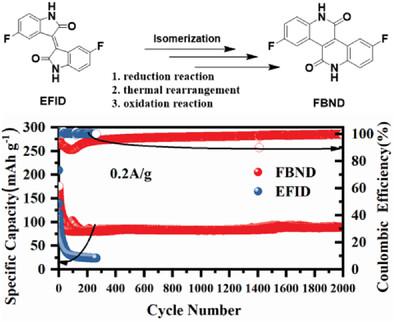Our official English website, www.x-mol.net, welcomes your feedback! (Note: you will need to create a separate account there.)
Long Cycle Life for Rechargeable Lithium Battery using Organic Small Molecule Dihydrodibenzo[c,h][2,6]naphthyridine-5,11-dione as a Cathode after Isoindigo Pigment Isomerization
Advanced Science ( IF 14.3 ) Pub Date : 2023-11-30 , DOI: 10.1002/advs.202307134 Mingcong Yang 1, 2, 3 , Wei Hu 1 , Jun Li 1 , Tao Chen 3 , Shiqiang Zhao 1 , Xi'an Chen 1 , Shun Wang 1 , Huile Jin 1, 2
Advanced Science ( IF 14.3 ) Pub Date : 2023-11-30 , DOI: 10.1002/advs.202307134 Mingcong Yang 1, 2, 3 , Wei Hu 1 , Jun Li 1 , Tao Chen 3 , Shiqiang Zhao 1 , Xi'an Chen 1 , Shun Wang 1 , Huile Jin 1, 2
Affiliation

|
Sustainability and adaptability in structural design of the organic cathodes present promises for applications in alkali metal ion batteries. Nevertheless, a formidable challenge lies in their high solubility in organic electrolytes, particularly for small molecular materials, impeding cycling stability and high capacity. This study focuses on the design and synthesis of organic small molecules, the isomers of (E)-5,5′-difluoro-[3,3′-biindolinylidene]-2,2′-dione (EFID) and 3,9-difluoro-6,12-dihydrodibenzo [c, h][2,6]naphthyridine-5,11-dione (FBND). While EFID, characterized by a less π-conjugated structure, exhibits subpar cycling stability in lithium-ion batteries (LIBs), intriguingly, another isomer, FBND, demonstrates exceptional capacity and cycling stability in LIBs. FBND delivers a remarkable capacity of 175 mAh g−1 at a current density of 0.05 A g−1 and maintains excellent cycling stability over 2000 cycles, retaining 90% of its initial capacity. Furthermore, an in-depth examination of redox reactions and storage mechanisms of FBND are conducted. The potential of FBND is also explored as an anode in lithium-ion batteries (LIBs) and as a cathode in sodium-ion batteries (SIBs). The FBND framework, featuring extended π-conjugated molecules with an imide structure compared to EFID, proves to be an excellent material template to develop advanced organic small molecular cathode materials for sustainable batteries.
中文翻译:

异靛蓝颜料异构化后以有机小分子二氢二苯并[c,h][2,6]萘啶-5,11-二酮为正极的可充电锂电池的长循环寿命
有机阴极结构设计的可持续性和适应性为碱金属离子电池的应用带来了希望。然而,一个巨大的挑战在于它们在有机电解质中的高溶解度,特别是对于小分子材料来说,阻碍了循环稳定性和高容量。本研究重点是有机小分子的设计和合成,异构体为(E)-5,5'-二氟-[3,3'-联二吲哚基]-2,2'-二酮(EFID)和3,9-二氟-6,12-二氢二苯并[c,h][2,6]萘啶-5,11-二酮(FBND)。虽然 EFID 具有较少的 π 共轭结构,在锂离子电池 (LIB) 中表现出低于标准的循环稳定性,但有趣的是,另一种异构体 FBND 在 LIB 中表现出出色的容量和循环稳定性。FBND在0.05 A g -1的电流密度下提供了175 mAh g -1的卓越容量,并在2000次循环后保持优异的循环稳定性,保留了90%的初始容量。此外,还对 FBND 的氧化还原反应和存储机制进行了深入研究。FBND 作为锂离子电池(LIB)阳极和钠离子电池(SIB)阴极的潜力也得到了探索。与 EFID 相比,FBND 框架具有扩展的 π 共轭分子和酰亚胺结构,被证明是开发用于可持续电池的先进有机小分子阴极材料的绝佳材料模板。
更新日期:2023-11-30
中文翻译:

异靛蓝颜料异构化后以有机小分子二氢二苯并[c,h][2,6]萘啶-5,11-二酮为正极的可充电锂电池的长循环寿命
有机阴极结构设计的可持续性和适应性为碱金属离子电池的应用带来了希望。然而,一个巨大的挑战在于它们在有机电解质中的高溶解度,特别是对于小分子材料来说,阻碍了循环稳定性和高容量。本研究重点是有机小分子的设计和合成,异构体为(E)-5,5'-二氟-[3,3'-联二吲哚基]-2,2'-二酮(EFID)和3,9-二氟-6,12-二氢二苯并[c,h][2,6]萘啶-5,11-二酮(FBND)。虽然 EFID 具有较少的 π 共轭结构,在锂离子电池 (LIB) 中表现出低于标准的循环稳定性,但有趣的是,另一种异构体 FBND 在 LIB 中表现出出色的容量和循环稳定性。FBND在0.05 A g -1的电流密度下提供了175 mAh g -1的卓越容量,并在2000次循环后保持优异的循环稳定性,保留了90%的初始容量。此外,还对 FBND 的氧化还原反应和存储机制进行了深入研究。FBND 作为锂离子电池(LIB)阳极和钠离子电池(SIB)阴极的潜力也得到了探索。与 EFID 相比,FBND 框架具有扩展的 π 共轭分子和酰亚胺结构,被证明是开发用于可持续电池的先进有机小分子阴极材料的绝佳材料模板。







































 京公网安备 11010802027423号
京公网安备 11010802027423号